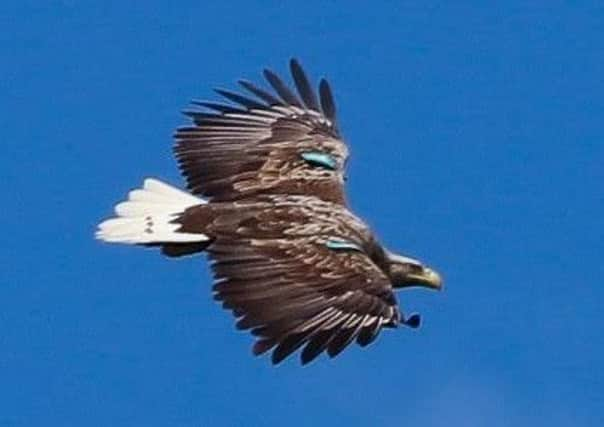Twin chicks mark 10 years of sea eagles in eastern Scotland


The twin chicks are the offspring of birds brought from Norway as part of a project that saw the species returned to eastern Scotland after an absence of almost 200 years.
The sea eagle, also known as the white-tailed eagle, is the nation’s largest bird of prey.
Advertisement
Hide AdAdvertisement
Hide AdOften dubbed the “flying barn door” because of its 8ft wingspan, it was a common sight across Scotland during the 19th century.
It was driven to extinction in Britain as a result of persecution by humans, with the last native bird shot dead in Shetland in 1918.
But the iconic birds of prey can now be seen around Tentsmuir Forest, in north-east Fife, where they are regular visitors throughout the year.
The East Scotland Sea Eagles scheme, a partnership between Forest Enterprise Scotland (FES), conservation charity RSPB Scotland and government agency Scottish Natural Heritage, involved 85 Norwegian birds being released on Scotland’s east coast between 2007 and 2012.
It is the third stage of a wider reintroduction programme that began more than 40 years ago.
The parents – named Turquoise 1 and Turquoise Z, after their wings tags – were released in 2009.
They produced the project’s first chicks in 2013, and have bred successfully every year since.
The latest hatchlings have emerged as the scheme celebrates 10 years.
Advertisement
Hide AdAdvertisement
Hide AdGraeme Findlay, environment manager with the FES team in Tay, said: “We are delighted that in this, the 10th anniversary of the project launch, that our star pair of white-tailed eagles have once again hatched chicks in Fife.
“The birds kept us waiting, laying later than usual, but for everyone involved in the project we are delighted that they have successfully hatched twins.
“It is because of the commitment and enthusiasm of the team of volunteers who watch the nest that we know exactly when the chicks hatched, and we also get a fantastic record of the day-to-day activities of the birds.”
Owen Selly, RSPB Scotland sea eagle project officer said: ”It’s fantastic news that we have had two chicks hatch again this year, and fingers crossed both will fledge successfully.
“The chick that fledged from the Fife nest last year, White L, is now a year old and we have been able to monitor his travels thanks to his satellite tag.
“He has spent time in Deeside and Perthshire over the winter, meeting up with White Diamond, a female who fledged from a nest in Speyside.”
Sea eagles were first released in Scotland on the Isle of Rum in 1975, then in Wester Ross between 1993 and 1998.
The first chick bred in the wild since UK extinction was born on Mull in 1985.
Advertisement
Hide AdAdvertisement
Hide AdThere are now more than 200 individuals across the country, including more than 50 breeding pairs on the west coast.
Their huge wingspan and striking white tail has made them a magnet for tourists in areas such as Skye and Mull, where research suggests the species is worth £5 million a year to the local economy.